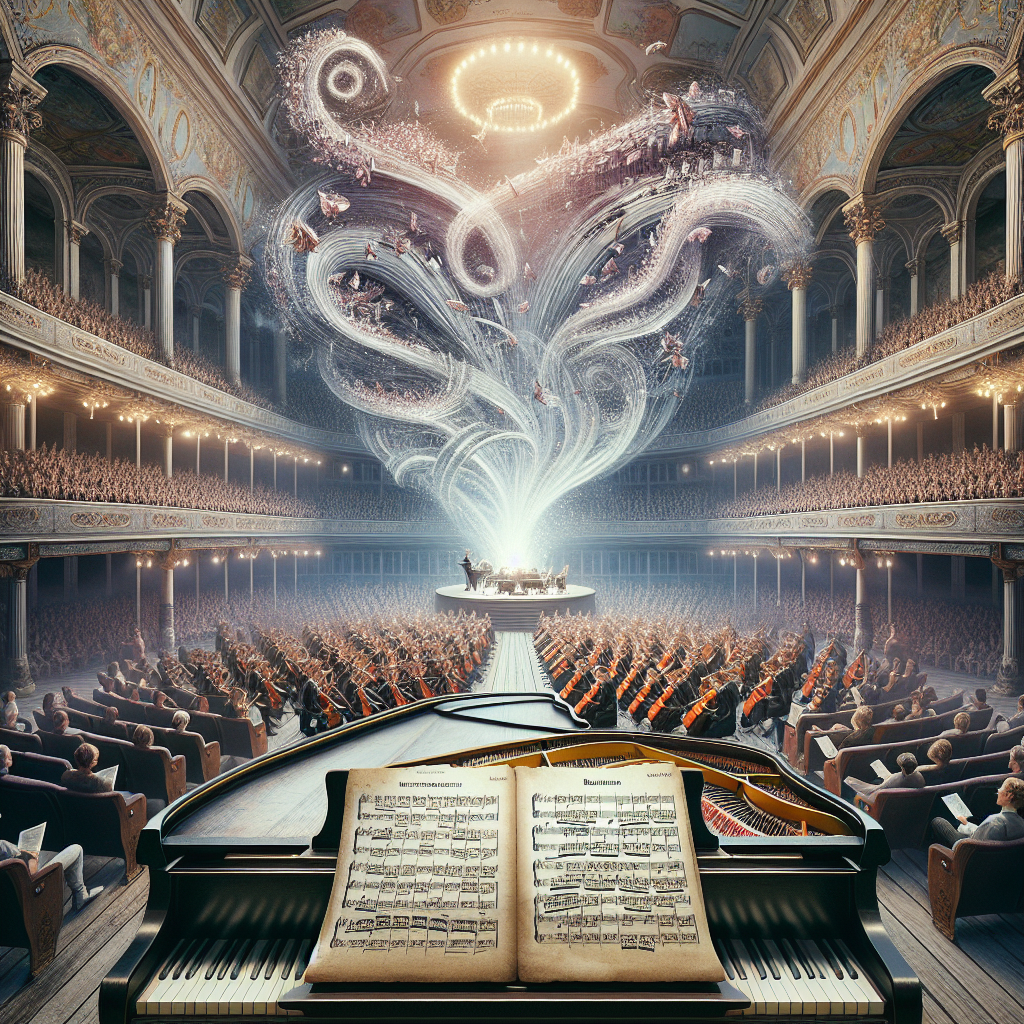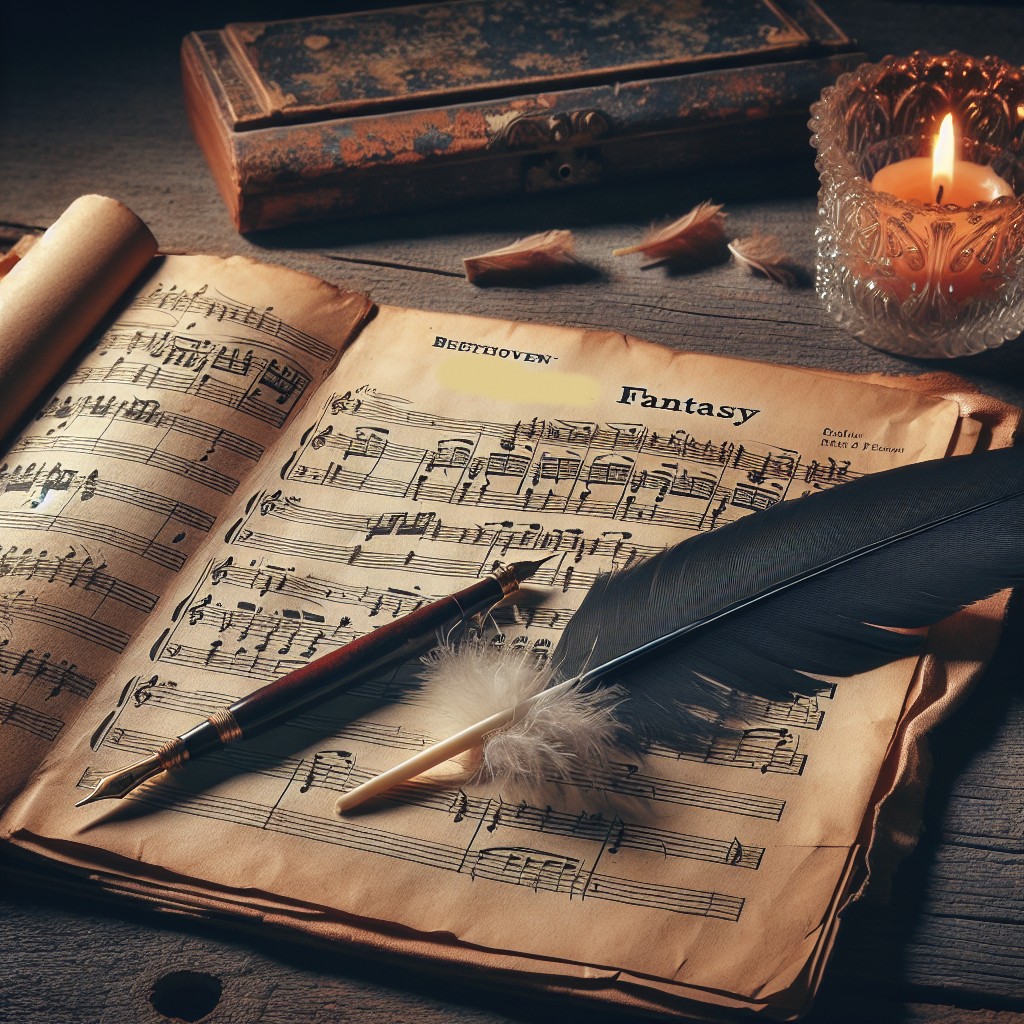
Beethoven’s Choral Fantasy – A Precursor to the Ninth Symphony
Ludwig van Beethoven, an indomitable figure in the history of Western classical music, left an indelible mark on the world with his innovative compositions and masterful symphonies. While many are familiar with his symphonies, piano sonatas, and chamber music, his vocal and choral works, particularly the “Choral Fantasy” and the iconic Ninth Symphony, embody a powerful fusion of orchestral and vocal elements. These works highlight Beethoven’s ability to blur the boundaries between genres and innovate in ways that have inspired countless musicians and composers since.
The “Choral Fantasy,” composed in the auspicious year of 1808 and first performed in one of the most legendary concerts in history, stands as a monumental piece that bridges Beethoven’s earlier period to his late masterpieces. Often overshadowed by the grandeur of the Ninth Symphony, the “Choral Fantasy” is an essential chapter in Beethoven’s oeuvre, demonstrating his knack for thematic development and his early experiments with integrating vocal forces into instrumental music.
This article delves into the historical context, compositional features, and influence of Beethoven’s “Choral Fantasy,” while underlining its significance as a precursor to the magnum opus that is the Ninth Symphony. By exploring the genesis and reception of the “Choral Fantasy,” we can gain a deeper understanding of Beethoven’s evolving artistic vision and the profound impact of his choral works on the musical landscape.
Historical Context of the Choral Fantasy
The “Choral Fantasy” was composed during a time of remarkable productivity for Beethoven. The year 1808 was particularly significant, as it saw the premiere of several of his major works, including the Fifth and Sixth Symphonies, the Fourth Piano Concerto, and the Mass in C major. Beethoven was already renowned for his virtuosic piano compositions and symphonic works, and he sought to push the boundaries of traditional forms by incorporating choral and vocal elements.
The premiere of the “Choral Fantasy” took place on December 22, 1808, at the Theater an der Wien in Vienna. This concert, often referred to as the “Academy,” was an ambitious and lengthy affair featuring solely Beethoven’s compositions. Amidst freezing conditions and a grueling program that stretched for several hours, the “Choral Fantasy” emerged as an innovative amalgamation of solo piano, orchestra, and choir.
The “Choral Fantasy” was initially conceived as a piece that would amalgamate various elements of Beethoven’s compositional style. What makes this work particularly fascinating is its structure, which begins with an elaborate piano solo that transitions into an orchestral arrangement, culminating in a choral finale. This innovative blend hinted at Beethoven’s burgeoning ideas for later works, especially the Ninth Symphony, which famously features a choral finale with Friedrich Schiller’s “Ode to Joy.”
Structural and Thematic Analysis
The “Choral Fantasy” is a multi-sectional work that unfolds over approximately twenty minutes. Its structure is unique, starting with an improvised-sounding piano fantasia, which Beethoven himself would have likely performed at the premiere. This introduction sets the stage for a series of orchestrations and variations on a theme that Beethoven meticulously developed.
The thematic material of the “Choral Fantasy” is quintessentially Beethovenian, characterized by its lyrical melodies, rhythmic drive, and harmonic exploration. The piano introduction is followed by a series of variations that feature interplay between the piano, orchestra, and eventually, the chorus. One of the distinguishing features of this piece is how the thematic material evolves and transforms throughout the composition, leading to a powerful and harmonically rich choral finale.
The text of the choral finale, written by Christoph Kuffner, a poet and contemporary of Beethoven, exudes a sense of universal brotherhood and joy—a theme that would later resurface with greater profundity in the Ninth Symphony. The words extol the virtues of art and music as unifying forces, reflecting Beethoven’s Enlightenment ideals and humanistic values.
The “Choral Fantasy” holds a special place in Beethoven’s body of work not only for its structural innovation but also for its thematic connections. The piece bears stylistic similarities to Beethoven’s earlier piano concertos while foreshadowing elements of his later symphonic and choral compositions.

Connection to the Ninth Symphony
When examining Beethoven’s “Choral Fantasy” in the context of his larger body of work, it is impossible to overlook its clear role as a precursor to the Ninth Symphony. While the “Choral Fantasy” may not boast the same degree of fame as the Ninth Symphony, its choral finale represents an early manifestation of Beethoven’s vision for integrating vocal forces into symphonic structures.
The Ninth Symphony, completed in 1824, stands as one of the most influential compositions in the Western musical canon. Its final movement, an orchestral and vocal setting of Schiller’s “Ode to Joy,” is a culmination of Beethoven’s lifelong exploration of unity and universal humanism. The “Choral Fantasy,” composed sixteen years earlier, can be seen as an experimental groundwork for this symphonic masterpiece.
One of the most notable aspects of the “Choral Fantasy” is its exploration of thematic material that would later be developed more fully in the Ninth Symphony. Both works emphasize themes of joy, brotherhood, and the transcendent power of music. The integration of vocal and instrumental elements in the “Choral Fantasy” can be seen as a prototype for the Ninth Symphony’s choral finale, which elevates the symphony to a new level of artistic expression.
By creating the “Choral Fantasy,” Beethoven was able to experiment with various approaches to unifying these diverse elements. This experimentation laid the foundation for his later work, allowing him to refine and expand on these ideas in the Ninth Symphony. The “Choral Fantasy” hence represents both a continuation of Beethoven’s earlier efforts and a significant step towards his late style.
Reception and Legacy
The initial reception of the “Choral Fantasy” was mixed, partly due to the imperfect conditions under which it was first performed. The immense length of the 1808 concert, combined with the freezing venue and a few musical missteps, meant that audiences were not immediately enamored with the piece. However, over time, the “Choral Fantasy” has come to be appreciated for its innovative structure and the foresight it represented in Beethoven’s development as a composer.
Scholars and musicians have since recognized the “Choral Fantasy” as a crucial work in Beethoven’s catalog. It provides insight into his creative process and serves as a key link between his middle and late periods. The piece continues to be performed and recorded, celebrated not only for its own merits but also for its pivotal role in the evolution of Beethoven’s symphonic style.
The legacy of the “Choral Fantasy” extends beyond its immediate impact on Beethoven’s subsequent works. It has influenced generations of composers, from Brahms to Mahler, who have looked to Beethoven’s integration of choral elements into symphonic form as a model for their own compositions. The piece’s thematic material and structural experimentation paved the way for future innovations in classical music.
Furthermore, the “Choral Fantasy” has maintained a presence in contemporary classical music and popular culture. Its themes of unity and the power of music resonate with modern audiences, echoing the timeless messages that Beethoven sought to convey through his compositions.
The Choral Fantasy Today
In the contemporary musical landscape, Beethoven’s “Choral Fantasy” continues to be a subject of interest for performers and scholars alike. Its performance offers modern audiences a glimpse into Beethoven’s experimental phase, showcasing his ability to blend various musical forms and elements into a cohesive and groundbreaking work.
Modern interpretations of the “Choral Fantasy” often highlight its improvisatory nature, with solo pianists bringing their own interpretations to the opening fantasia. Conductors and orchestras also strive to emphasize the thematic continuity between the piano, orchestral, and choral parts, ensuring that the piece is presented as a unified whole. Advances in historical performance practice have also allowed musicians to explore the piece in greater depth, using period instruments and techniques to bring out the nuances of Beethoven’s original vision.
Educational programs and musicological research continue to shed light on the “Choral Fantasy” and its place within Beethoven’s oeuvre. Studies of the piece often focus on its structural innovations and thematic connections to the Ninth Symphony, providing valuable insights into Beethoven’s creative process and the evolution of his compositional style.
In addition to its significance within the classical music canon, the “Choral Fantasy” also finds relevance in contemporary culture. Its themes of joy and unity, coupled with its historical importance, make it a popular choice for concerts celebrating significant events and anniversaries. The piece’s ability to convey a message of hope and solidarity resonates with audiences today, just as it did over two centuries ago.
Conclusion
Ludwig van Beethoven’s “Choral Fantasy” stands as a testament to the composer’s relentless pursuit of innovation and his visionary approach to music. By blending elements of piano fantasia, orchestral variations, and choral finale, Beethoven crafted a work that serves as both a reflection of his past achievements and a harbinger of his future masterpieces.
While the “Choral Fantasy” may not enjoy the same level of recognition as the Ninth Symphony, its significance as a precursor to that monumental work cannot be overstated. The “Choral Fantasy” embodies Beethoven’s experimentation with form, his exploration of thematic unity, and his belief in the transcendent power of music.
The historical context, structural innovations, and thematic connections between the “Choral Fantasy” and the Ninth Symphony highlight Beethoven’s evolving artistic vision and his enduring impact on the world of classical music. The piece’s reception and legacy further underscore its importance as a key work in Beethoven’s catalog, influencing generations of composers and musicians.
In celebrating the “Choral Fantasy,” we honor Beethoven’s legacy as a composer who dared to push the boundaries of musical expression. The piece continues to inspire and resonate with audiences today, reminding us of the timeless beauty and universal message inherent in Beethoven’s music.